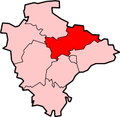| Butterleigh | |
|---|---|
 St Matthews Church in Butterleigh | |
Location within Devon | |
| Population | 110 (2021 UK Census) |
| District | |
| Shire county | |
| Region | |
| Country | England |
| Sovereign state | United Kingdom |
| Police | Devon and Cornwall |
| Fire | Devon and Somerset |
| Ambulance | South Western |
| UK Parliament | |
Butterleigh is a village and civil parish in Mid Devon, England situated about three miles south east of Tiverton. The village includes a public house, [1] village hall, award-winning blacksmith and is famous for its harvest home.

